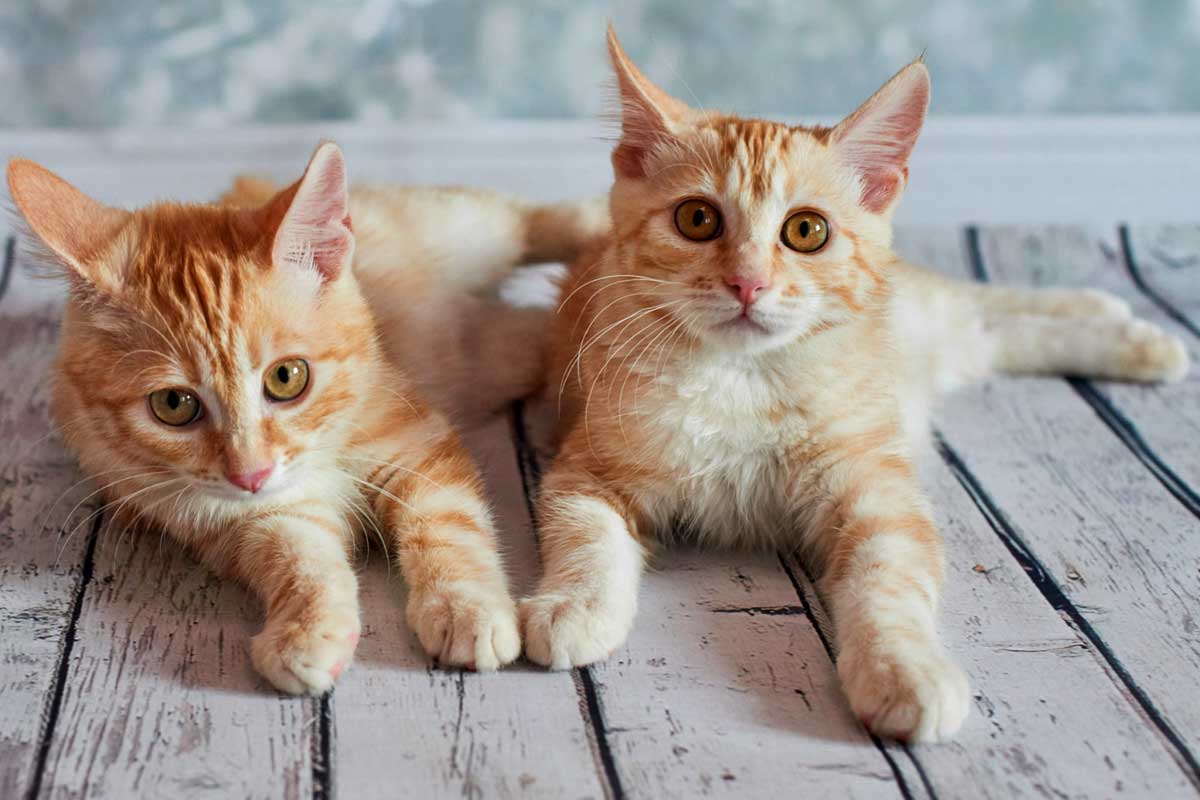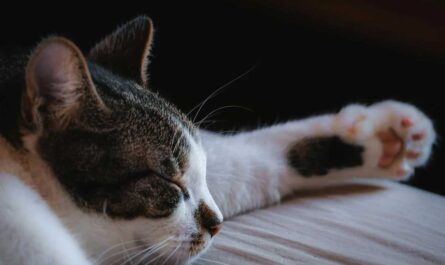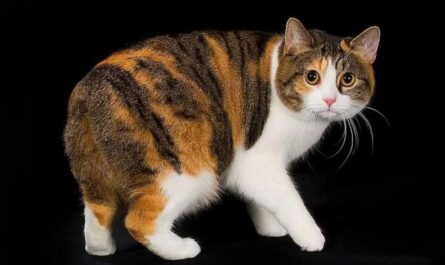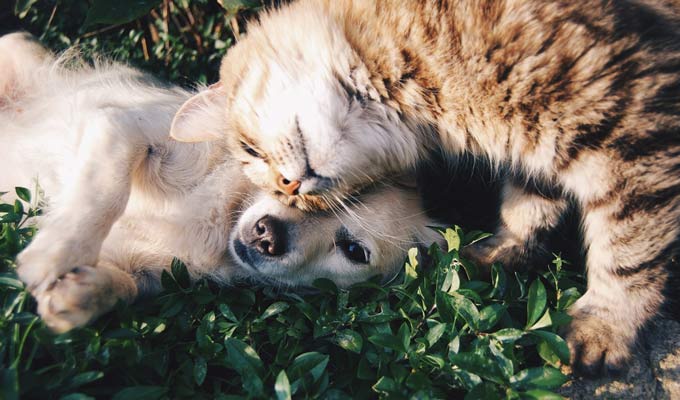How to introduce a new kitten to an older cat? Embarking on the delightful journey of welcoming a new kitten into your home is exhilarating, yet the prospect of orchestrating an introduction with your resident adult cat can evoke understandable trepidation. Fear not, as meticulous preparation can transform this transition into a harmonious bonding experience. Initiating this process entails not just a casual readiness, but a meticulous orchestration of your living space.
Navigating the Landscape of Cat Introductions
The introduction of a new kitten into the feline family dynamic is an art that demands finesse and strategic planning. Ensuring that both cats coexist harmoniously necessitates a gradual approach, spanning weeks to months. The goal is for them to recognize each other as integral components of a shared social group. However, this journey is not without its share of hissing and disagreements. The orchestration of a harmonious feline coexistence is a symphony of patience, observation, and strategic facilitation, wherein the unique personalities of your furry companions harmonize to create a melodic household dynamic.
While these initial conflicts are a normal part of the adjustment process, persistent problems may signal the need for intervention. Seeking guidance from a veterinarian or a professional behaviorist can offer valuable insights into resolving ongoing issues. This final thought underscores the importance of a measured and thoughtful approach to integrating a new kitten into the existing feline hierarchy, emphasizing that the journey to harmonious cohabitation is a nuanced one, requiring diligence and, when necessary, expert counsel.
Preparing Your Home
Choose a designated haven within your residence to confine the newest member of your feline family during the crucial settling-in period. A spare bedroom, replete with the essentials, becomes the sanctuary where the kitten acclimates to its new surroundings. In this sequestered space, provision must be made for sustenance, hydration, hiding nooks, a pristine litter box, and a repertoire of toys to stimulate the inquisitive spirit of your burgeoning companion. Crucially, ensure that potential hazards such as dangling wires and open windows are conspicuously absent from this feline haven.
Simultaneously, acknowledge the territorial instincts of your established cat by designating a secure domain where they can retreat from the charming yet potentially intrusive newcomer. Separation is key to affording your seasoned feline the luxury of solitude amid the tumult of change. Moreover, resist the temptation to intermingle their belongings prematurely; cats, inherently private beings, are averse to sharing, especially when it comes to litter boxes. The cardinal rule here is one box per cat, plus an additional one for good measure.
Consider the implementation of a pheromone diffuser, such as Feliway, to foster a tranquil atmosphere for both parties. These artificial cat pheromones serve as a balm, preventing your elder cat from feeling encroached upon and aiding them in unwinding amid the shifting dynamics.
Bringing Your New Kitten Home
The introduction of your newfound bundle of fur to their new abode demands a delicate orchestration that extends beyond mere spatial confinement. Strategic steps are imperative to ensure a seamless assimilation, beginning with acquainting your resident cat with the olfactory signature of their incoming compatriot.
In the preliminary phase, the scent of the newcomer becomes the ambassador of amicable overtures. Scent swapping, an ingenious stratagem in the feline social lexicon, allows both cats to familiarize themselves with each other’s essence before the face-to-face encounter. This olfactory diplomacy involves interchanging blankets from their respective bedding areas, a ritual of mutual olfactory exploration.
Attentiveness is crucial during this juncture. Positive behaviors, such as inquisitive sniffing, are welcome indicators of acceptance. Conversely, vigilant observation is paramount for signs of discord—hissing or blanket avoidance could presage potential confrontations. If such signs manifest, prudence dictates a recalibration, allowing the feline protagonists more time to acclimate to one another’s aromatic presence.
As the days unfold and the cats display signs of relaxation in the mutual olfactory milieu, the time is ripe to graduate to the next phase. Gradually, introduce the elder cat to the kitten’s living quarters. This intermingling serves as a precursor to the eventual face-to-face rendezvous. It is an incremental process, one where patience and astute observation reign supreme.
The pièce de résistance of this choreography is letting the two feline forces of nature lay eyes on each other through a tangible barrier—an ajar door, a window, or a strategically positioned baby gate. This visual preamble, ideally extended over a week, facilitates positive associations, fostering an environment conducive to a harmonious cat union. The staged introduction builds anticipation, ensuring that when the momentous meeting finally transpires, it unfolds as a grand symphony of feline camaraderie.
How long does it take for a cat to get used to a new kitten?
The delicate choreography of acclimating a cat to a new feline companion is an intricate dance, with the timeline of adjustment as diverse as the cats themselves. This transitional period, laden with nuances, spans a spectrum from a mere few weeks to the more protracted expanse of several months. In this feline tango, patience emerges as the linchpin; a virtue indispensable when orchestrating the introduction of a sprightly new kitten to the domain of an elder cat. The coalescence of their worlds into a harmonious cohabitation demands the investment of time, where the cadence of their relationship evolves into a symphony of shared spaces and peaceful coexistence.
What do I do if my cat doesn’t like my new kitten?
Navigating the labyrinth of feline dynamics requires astute observation and judicious intervention when discord surfaces. Should the seasoned resident cat manifest signs of aggression towards the interloping kitten, a strategic retreat is imperative. Retracing steps in the introduction process become the modus operandi, infusing an element of supervision into every interaction. The arsenal of conflict mitigation extends to the realms of scent swapping, wherein olfactory exchanges pave the way for a more amicable truce. The physical demarcation of space, facilitated by barriers, acts as a crucible for conflict avoidance, ensuring the gradual emergence of a détente between the two feline entities.
Encourage Your Kitten To Get Out And Explore
Embarking on the journey of integrating a new kitten into your household is a delicate process that demands both patience and attentiveness. As the initial phase unfolds, exercising patience becomes paramount. The art of introduction among feline companions is an intricate dance, necessitating a significant investment of time before a harmonious coexistence is achieved.
A pivotal moment arises approximately a week into this nuanced process when your furry companion, confined to a limited space, may exhibit signs of burgeoning frustration. These manifestations are multifaceted, encompassing actions such as incessant meowing, persistent scratching at doors or windows, restive pacing to and fro, attempts at escape, or even a swiping gesture directed at you upon leaving the room.
If your kitten, ensconced in their newfound environment, begins to exude an air of comfort and relaxation, a transformative shift is in progress. The telltale signs of this positive transformation include an amiable disposition, marked by friendly gestures, contented purring, an inviting display of their belly, indicative of a desire for affectionate rubbing, joyful engagement in play, and a peculiar yet endearing habit of rubbing their facial glands on furniture and various items, leaving an olfactory calling card that asserts their territorial presence.
Navigating this critical juncture entails granting your feline companion the freedom to explore designated sections of the abode, always under vigilant observation. This intentional exposure is not solely for the benefit of the fledgling kitten but plays a crucial role in familiarizing your older cat with the newest member of the household. The older cat, witness to the exploratory escapades, assimilates the visual evidence that cements the kitten’s status within the familial hierarchy.
Stay Patient Through the Introductions
The paramount ingredient in this delicate concoction of feline introductions is time. As the days unfold, the dynamic between the feline denizens of your abode begins to evolve, paving the way for a harmonious cohabitation. The signs of this evolution are subtle yet profound, manifesting in the cessation of overtly territorial behaviors and the gradual emergence of a mutual acknowledgment that transcends the confines of personal space.
The metamorphosis from initial unease to an established familial rapport is a journey rife with nuanced interactions. During this period, it’s not uncommon for your older cat to exhibit a degree of reluctance or disapproval as the curious kitten meanders into their established domain. This initial discord is a natural facet of the assimilation process, requiring your understanding and a commitment to patience.
One strategy to preemptively mitigate potential issues is a thoughtful arrangement of your cat’s essentials—food and water bowls strategically placed away from the prying curiosity of the inquisitive kitten. This subtle separation of territories fosters a sense of security for the older cat, alleviating potential apprehensions and facilitating a smoother transition into the burgeoning family dynamic.
How To Introduce A New Kitten To An Older Cat: 16 Tips
Navigating the introduction of a new kitten to an older cat requires finesse, patience, and a profound appreciation for the intricate dance of feline relationships. By incorporating these nuanced tips, you embark on a journey towards fostering a harmonious coexistence between generations of whiskered companions. Navigating the introduction of a new kitten to an older cat demands finesse, akin to orchestrating a delicate ballet within the intricate world of feline dynamics. The established hierarchy and territorial instincts of the older cat pose challenges, weaving a tapestry of potential obstacles to the seamless integration of a tiny, curious newcomer. A nuanced comprehension of these underlying dynamics is paramount, a key that unlocks the door to a harmonious coexistence between the generations.
1. Gradual Introduction: A Prelude to Harmony
In the choreography of feline harmony, a pivotal strategy emerges—the gradual introduction of the new kitten to its more seasoned counterpart. Abrupt confrontations, like jarring discordant notes, can induce stress and anxiety in both feline entities, potentially crescendoing into behavioral issues. The initiation of acquaintance becomes a symphony in incremental stages, allowing the older cat to acclimate to the scent, sight, and sounds of the diminutive interloper.
2. Scent Exchange: Feline Olfactory Symphony
In the nuanced world of feline relations, where olfactory nuances reign supreme, the ballet of introduction unfolds through a feline olfactory symphony. Cats, with their world shaped predominantly by an acute sense of smell, engage in a ritual of scent exchange. Bedding and toys swap places between the two feline companions, creating an olfactory tableau that allows each to familiarize themselves with the nuanced scent signature of the other. This olfactory symphony serves as a gentle overture, fostering a delicate dance of mutual recognition and acceptance.
3. Safe Spaces: Establishing Territories
Amidst the dance of introduction, one must not forget the sanctuaries—the safe spaces that are the very foundations of feline reassurance. Cats, inherently territorial beings, find solace in these designated havens. Provide separate sanctuaries, each adorned with cozy beds, litter boxes, and food bowls, allowing for a retreat into individual realms when the need for solitude arises. These spaces become the quiet stages where the drama of integration unfolds.
4. Visual Introductions: The Art of Observation
Before the grand crescendo of a face-to-face rendezvous, a prelude of visual introductions takes center stage. Like an artful composition, utilize a baby gate or a cracked door to allow the felines to observe each other without the immediacy of direct physical contact. This controlled visual exchange becomes the canvas upon which the cats gradually paint a familiarity with each other’s body language—a masterpiece of curiosity rather than apprehension.
5. Controlled Encounters: Diplomacy in Action
In navigating the delicate terrain of feline introductions, exercising precision and control is paramount. When orchestrating a face-to-face meeting between an established cat and a newcomer, employ a cautious approach. Utilize a secure harness or a carrier for the fledgling kitten, affording the resident feline the space to dictate the pace of their interaction. Vigilance is key—scrutinize their every move, intervening judiciously at the first inkling of aggression or discomfort. Gradually, like the slow unfurling of a delicate blossom, extend the duration of these supervised encounters. This gradual exposure serves as the crucible for the forging of a burgeoning familiarity between the two feline counterparts.
6. Positive Reinforcement: Culinary Allure
In the intricate dance of feline diplomacy, the culinary realm emerges as a potent arena for shaping perceptions. During those tentative initial encounters, tantalize the senses of both cats with delectable treats or specially prepared meals. The aroma of these culinary delights becomes a shared sensory experience, weaving a tapestry of positive associations. This culinary communion transforms mere interactions into moments pregnant with anticipation and shared delight. Through this gastronomic allure, the threads of connection between the two feline entities are woven into a fabric of mutual pleasure.
7. Interactive Play: Bridging Generational Gaps
Within the rich tapestry of feline communication, play stands as a universal language, transcending the boundaries of age. In the delicate choreography of introducing an elder cat to a playful kitten, orchestrate interactive play sessions as the bridge that spans generational gaps. Employ toys that beckon both participants into joint engagement, fostering a sense of camaraderie through shared playtime escapades. This dynamic interaction not only entertains but also forges a foundational understanding, weaving a seamless connection between the seasoned elder and the spirited newcomer.
8. Patience: The Virtue of Harmony
In the nuanced world of feline introductions, the currency that buys harmony is patience—a virtue akin to the gentle unfurling of petals in a time-laden garden. Recognize and embrace the inherent variability in the timeline for acceptance between feline pairs. Some may forge bonds with swiftness, akin to a musical crescendo, while others necessitate the slow and deliberate passage of weeks or even months. The art of feline diplomacy demands patience that allows the relational tapestry to unfold organically, each thread weaving into a harmonious composition at its own pace.
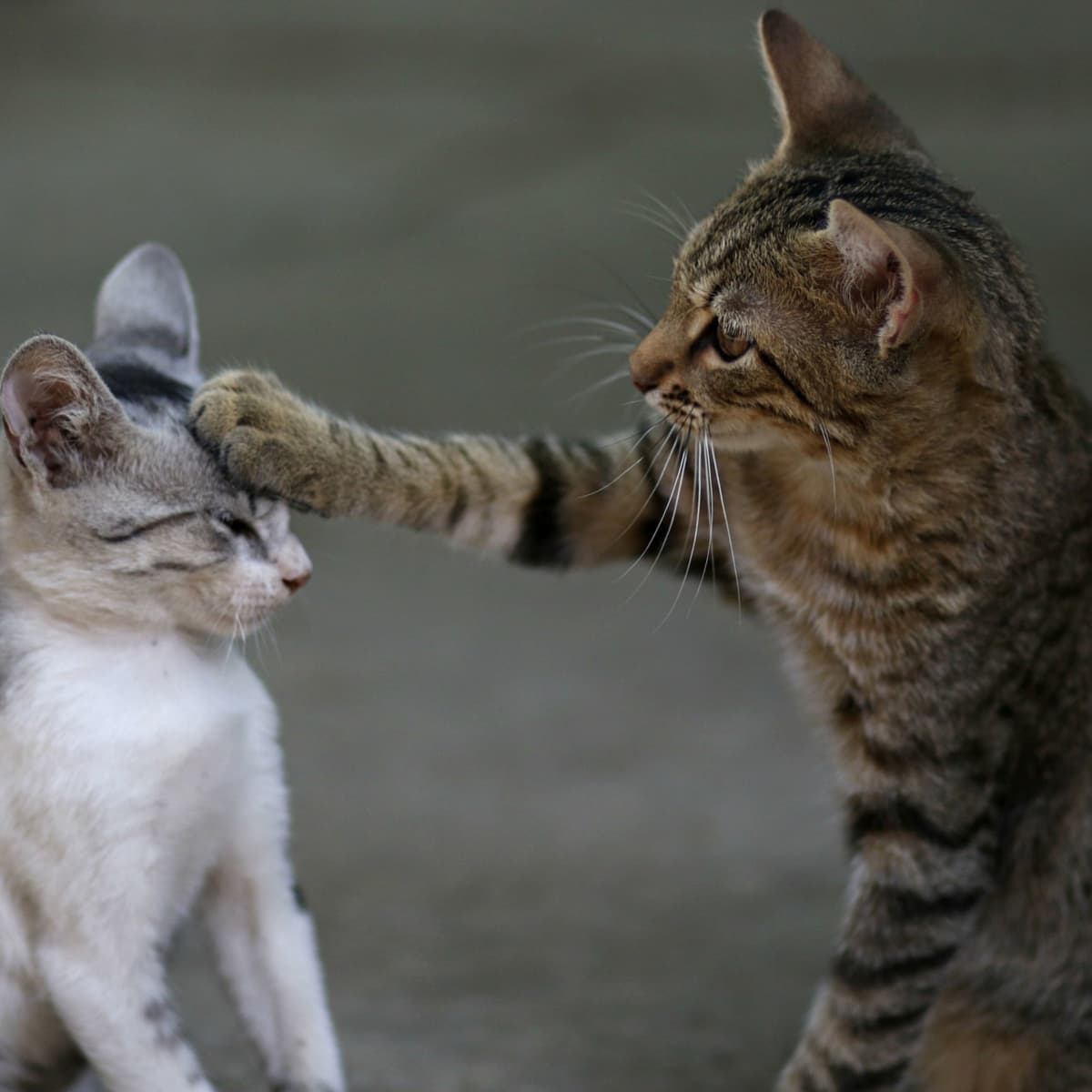
9. Veterinary Consultation: Expert Guidance
Embarking on the odyssey of feline introductions warrants seeking the sagacious counsel of veterinary professionals. These guardians of feline well-being possess the knowledge to decipher the nuanced dynamics at play. Through tailored advice, rooted in an understanding of the specific personalities and health considerations of the cats involved, a veterinarian becomes the compass guiding the journey. This expert guidance transcends the mere physical, delving into the emotional intricacies of the feline psyche. In the sanctuary of veterinary wisdom, a holistic approach unfolds, ensuring the well-being of both the body and soul of the feline companions.
10. Environmental Enrichment: Stimulating Surroundings
In the intricate dance of feline relationships, the concept of environmental enrichment unfurls as a masterstroke, weaving a tapestry that transcends the mundane. It is not merely about the provision of scratching posts and climbing structures but about curating an ecosystem that pulsates with vitality, resonating with the heartbeat of each feline inhabitant. The symphony of interactive toys becomes a sensory feast, engaging not only the nimble paws of the older cat but also beckoning the inquisitive spirit of the new kitten. This dynamic environment, teeming with diversions, serves as a sanctuary, a refuge from the potential discord that may linger in the air. It’s a delicate ballet of textures and stimuli, a sanctuary where boredom dissipates, and tensions find themselves outpaced by the allure of a richly adorned feline haven.
11. Feline Body Language: Deciphering Cues
In the enigmatic realm of feline communication, the ability to decipher the silent ballet of body language is akin to wielding a key to a cryptic lexicon. Each twitch of the whiskers, the subtle arch of the back, and the flicker of the tail are strokes in a portrait painted with nuanced intention. It’s a non-verbal symphony, an orchestra of cues that narrates the emotional landscape of these enigmatic creatures. Observing these subtleties becomes an art, a language of empathy that transcends spoken words. The astute observer, armed with this lexicon, possesses the power to intervene in the delicate choreography of cat interactions, nipping potential conflicts in the bud and orchestrating a harmonious integration where every gesture becomes a note in a silent sonnet.
12. Individualized Affection: Tailoring Attention
In the realm of feline dynamics, one size does not fit all. The art of cultivating harmony between the older cat and the new kitten is an exercise in tailoring affection to the unique preferences of each individual. It’s a bespoke journey, where understanding the idiosyncrasies of cuddling aficionados and independent souls alike becomes paramount. Like a skilled artisan crafting a masterpiece, you weave a tapestry of attention that respects the boundaries of personal space while fostering an environment where both the demure purrs and the spirited chirrups harmonize. It’s a delicate dance, an acknowledgment that affection wears diverse masks, and the true maestro is the one who conducts this symphony with a keen sensitivity to the distinct melodies each feline heart sings.
13. Routine Consistency: Stability Amidst Change
Amidst the whirlwind of change that accompanies the introduction of a new kitten, the anchor of routine emerges as the stabilizing force in the feline cosmos. It’s not merely about the clockwork precision of feeding times or the rhythmic cadence of play sessions; it’s about weaving a cloak of predictability that envelopes the feline companions. In the face of transformative upheaval, the constancy of routine becomes a balm, a reassuring cadence that whispers to the feline psyche, assuring them that amidst the flux, some things remain unchanged. It’s a testament to the profound truth that stability in routine is the cornerstone upon which the fortress of feline security stands.
14. Monitoring Health: Vigilance Beyond Behavior
While the silent language of feline behavior narrates tales of camaraderie and occasional skirmishes, the vigilant guardian delves beyond the surface, recognizing that health is the silent conductor orchestrating the symphony of feline well-being. Regular veterinary check-ups become a ritual, a pilgrimage to the temple of holistic care where the older cat and the new kitten are examined with an unerring eye for subtleties. It’s a commitment to preemptive care, a promise to address the whispers of potential health concerns before they crescendo into discordant notes. In this meticulous monitoring, the caretaker assumes the role of a vigilant sentinel, ensuring that the canvas of feline interaction is painted with vibrant hues of vitality.
15. Celebrating Success: Milestones of Harmony
As the sun sets and rises in the feline abode, it’s imperative to cast a spotlight on the moments of harmony that bloom like rare orchids in the garden of cat companionship. Each shared nap is a sonnet of camaraderie, a testament to the blossoming friendship between the older cat and the new kitten. A playful chase becomes a choreography of joy, and a synchronized grooming session is a tactile poem of unity. It’s about more than just acknowledging these milestones; it’s about reveling in them, basking in the warmth of a shared moment, and reinforcing the foundation of affection with the mortar of positive reinforcement. In these celebrations, the caretaker becomes the architect of an enduring bond, crafting a legacy of companionship that withstands the test of feline time.
16. Adaptability: Embracing the Unpredictable
In the labyrinth of feline introductions, adaptability emerges as the unsung hero, navigating the serpentine twists and turns with the grace of a seasoned dancer. It’s an acknowledgment that the journey to cohesion is not a linear trajectory but an odyssey marked by unforeseen detours. The open-minded caretaker becomes a guide, a compass that adjusts its needle to the ever-changing magnetic fields of feline dynamics. Embracing the unpredictable is an act of humility, a recognition that the feline narrative is an ever-evolving novel where each chapter may unfurl with the unexpected. In this dance with the unpredictable, the caretaker transforms into a conductor, orchestrating the symphony of adaptability that allows the older cat and the new kitten to compose their unique melody of togetherness.
Should I Encourage My Cats To Mix?
Contemplating the orchestrated mingling of your feline companions demands a nuanced understanding of their social dynamics. The genesis of your kitten’s socialization harks back to their formative days spent alongside their mother and littermates. Consequently, the transition into a new social setting, one inhabited by an older, pre-established cat, introduces an element of complexity.
The cardinal rule in this delicate dance is the avoidance of coercion. Attempts to forcefully integrate the feline duo can precipitate strife rather than fostering the desired camaraderie. Instead, the onus lies on facilitating an organic convergence, allowing the cats to navigate the intricacies of their budding relationship at their own pace.
Positive reinforcement emerges as a potent tool in this process, with praises, treats, and affection serving as catalysts for cultivating favorable interactions. These gestures become the adhesive that binds the cats’ burgeoning camaraderie, affirming the notion that acceptance into the social fold is accompanied by a cascade of affirmative experiences.
Will my cat hurt my new kitten?
Embarking on the odyssey of interspecies cohabitation engenders understandable concerns about the fragility of the smaller, fledgling member. While the likelihood of intentional harm may be remote, the prudence of vigilant supervision becomes an indomitable principle. The kitten’s diminutive stature and vulnerability necessitate a watchful eye, ensuring that interactions unfold within the contours of safety. Any whiff of impending conflict mandates a swift separation, preempting any inadvertent harm and fostering an environment where the symbiotic relationship can burgeon without the specter of unintended consequences.
Do female cats get along better with male or female cats?
The intricate tapestry of feline social dynamics unfurls with an air of enigma, debunking any categorical assertions regarding the compatibility of male and female counterparts. The fluidity of interpersonal dynamics in the feline realm renders gender-based generalizations moot. The alchemy of camaraderie transcends gender binaries, with the interplay of personalities emerging as the true arbiter of feline compatibility. While, at times, the resonances of affinity may align with the same gender, the specter of unneutered males engaging in territorial skirmishes introduces a variable, tempering any sweeping proclamations about gender predilections. See why thousands of cats love BoxCat
How to tell if the cat introduction is going well?
Deciphering the subtle nuances of a feline tête-à-tête mandates a keen eye for the language of cat communication. A positive trajectory in cat introductions manifests in a ballet of relaxed body language, signaled by unhurried blinks and a dearth of hissing or growling. The canvas of their interactions, painted with strokes of tranquility, epitomizes the success of the introduction endeavor. The absence of aggressive posturing becomes the proverbial litmus test, affirming that the overture of feline fellowship is unfolding as a harmonious sonnet.
What If They Don’t Get Along?
Introducing a new kitten to your home can be an exhilarating experience, but the prospect of your feline companions not getting along looms as a concern. Cats, by nature, are territorial creatures that establish a social hierarchy within their living space. The intricate dance of feline interaction involves a delicate balance of dominance and submission. In the context of introducing a new kitten, the existing older cat plays a pivotal role in this hierarchical arrangement.
The process of establishing a hierarchy is not instantaneous; rather, it unfolds over a span of weeks to months. During this period, expect your older cat to exhibit behaviors such as hissing and swiping. These seemingly aggressive acts are the feline way of communicating dominance and asserting their seniority as the original inhabitants of the shared territory. Understanding this natural progression is crucial to comprehending the dynamics of feline socialization. Cat accessories on Amazon
Takeaways: Decoding Feline Body Language
Monitoring your cats’ body language is akin to deciphering a silent conversation. A wary older cat may convey anxiety through subtle yet telling cues. Ears pressed back, wide-eyed stares and a low-set tail are indicative of unease. In more extreme cases, a frightened cat may puff up its fur, attempting to appear larger, while punctuating the tense atmosphere with hisses or growls. Such behaviors serve as a window into your cats’ emotional state, offering insights into the success or challenges of their budding relationship.
Encounters between the resident and newcomer may not always unfold harmoniously. It’s vital not to be disheartened by initial friction. Older cats, creatures of habit, require time to acclimate to the new addition. Rushing the introduction process risks sowing seeds of frustration and potential future problems. Patience becomes the guiding virtue, allowing the cats to gradually establish their rapport. Choosing moments of relaxation and playfulness for introductions can significantly contribute to a smoother assimilation.
Other Interesting Articles
- Cornish Rex Cat Breed: Profile, Traits, Health, Grooming, Care
- Colorpoint Shorthair Cat Breed: Profile, Traits, Grooming, Care
- Cheetoh Cat Breed: Profile, Traits, Health, Grooming, Care
- Chausie Cat Breed: Profile, Traits, Health, Grooming, Care
- Chartreux Cat Breed: Profile, Traits, Health, Grooming, Care
- Chantilly, or Tiffany Cat Breed: Profile, Traits, Grooming, Care
- Cymric Cat Breed: Profile, Traits, Health, Grooming, Care
- Dragon Li Cat Breed: Profile, Traits, Health, Grooming, Care
- Donskoy Cat Breed: Profile, Traits, Health, Grooming, Care
- European Shorthair Cat: Profile, Traits, Health, Grooming, Care
- German Rex Cat Breed: Profile, Traits, Health, Grooming, Care
- Havana Brown Cat Breed: Profile, Traits, Coats, Groom, Care
- Kurilian Bobtail Cat Breed: Profile, Traits, Coats, Groom, Care
- Korat Cat Breed Profile: Health, Traits, Coats, Groom, Care
- Javanese Cat Breed Profile: Health, Traits, Coats, Groom, Care
- Japanese Bobtail Cat Profile: Health, Traits, Coats, Groom, Care
- LaPerm Cat Breed Profile: Health, Traits, Coats, Groom, Care
- Manx Cat Breed Profile: Health, Traits, Coats, Groom, Care
- Nebelung Cat Breed Profile: Health, Traits, Groom, Care
- Norwegian Forest Breed Profile: Health, Traits, Groom, Care
